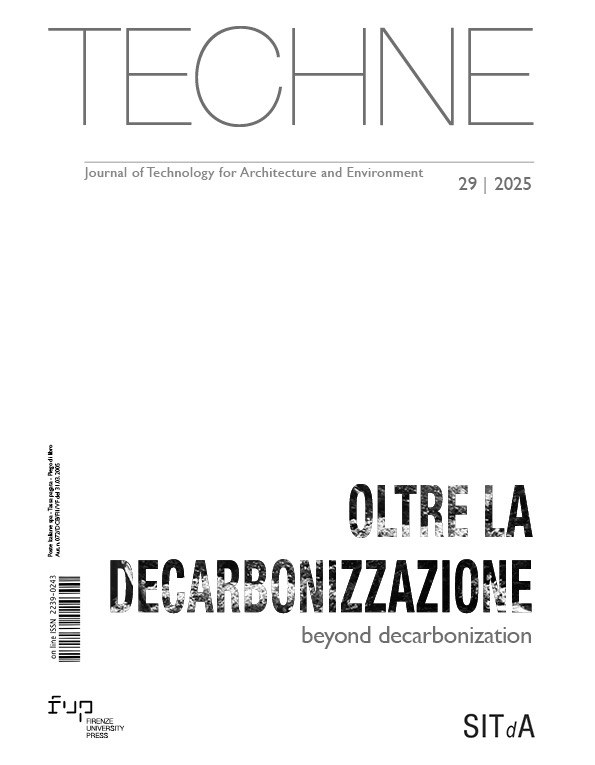Published 2025-07-31
Keywords
- Resource circularity,
- Solar energy,
- Bioclimatic passive systems,
- Her-itage buildings,
- Climate neutral
How to Cite
Copyright (c) 2025 Serena Baiani, Paola Altamura, Giada Romano

This work is licensed under a Creative Commons Attribution 4.0 International License.
Funding data
Abstract
This paper reports the results of research activities on the redevelopment of the historic built heritage in the urban context, a strategic and challenging field of investigation to achieve climate neutrality, sustainability and long-term resource conservation. The objective of the research is the development of a replicable and adaptable intervention model aimed specifically at historic buildings, which combines, according to the Cradle to Cradle approach, innovative circular and environmentally friendly technologies and systems, including passive bioclimatic systems and active integrated solar systems for energy production from RES. Among the research pilot cases, the contribution describes the experimentation for scenarios and gradients of integration and transformation of the existing building on the Ex Filanda in Rome.
Downloads
References
- Ahmed, N.M., Altamura, P., Giampaoletti, M., Fahd, A. H. and Abdelaziz Farouk, A. M. (2024), “Optimizing human thermal comfort and mitigating the urban heat island effect on public open spaces in Rome, Italy through sustainable design strategies”, Scientific Reports, Vol. 14, p. 19931. Available at: https://doi.org/10.1038/s41598-024-65794-8 (Accessed on 08/09/2024). DOI: https://doi.org/10.1038/s41598-024-65794-8
- Ambrogio, K. and Zuppiroli, M. (2013), Energia e restauro. Il miglioramento dell’efficienza energetica in sistemi aggregati di edilizia pre-industriale, tra istanze conservative e prestazionali, FrancoAngeli, Milano.
- Azouz, M. and Elariane, S. (2023), “Towards energy efficiency: retrofitting existing office buildings using smart technologies”, Journal of Engineering and Applied Science, Vol. 70, p. 147. Available at: https://doi.org/10.1186/s44147-023-00327-0 (Accessed on 06/09/2024). DOI: https://doi.org/10.1186/s44147-023-00327-0
- Baiani, S., Altamura, P., Turchetti, G. and Romano, G. (2024), “Energy transition e circular adaptive reuse del patrimonio industriale. Il caso dell’Ex Snia a Roma | Energy transition and circular adaptive reuse of industrial heritage. The case of the Ex Snia in Rome”, Agathón International Journal of Architecture, Art and Design, Vol. 15, pp. 190-203. Available at: https://doi.org/10.19229/2464-9309/15152024 (Accessed on 06/09/2024).
- Baiani, S., Altamura, P. and Turchetti, G. (2024), “Circular Contemporary Heritage. Design Experimentations on Conservation and Reuse Aiming at Material Resource Efficiency and Decarbonization”, in Bartolomei, C., Ippolito, A. and Vizioli, S.H.T. (Eds.), Contemporary Heritage Lexicon, pp. 435-478, Springer Tracts in Civil Engineering. Springer, Cham. Available at: https://doi.org/10.1007/978-3-031-61245-9_20 (Accessed on 06/09/2024). DOI: https://doi.org/10.1007/978-3-031-61245-9_20
- Baiani S., Altamura P., Lucchi E. and Romano G. (2023), “Integration of solar technologies in historical buildings: construction of an evolutionary framework of good practices”, in Sayigh, A. (Ed.), Mediterranean Architecture and the Green-Digital Transition. Innovative Renewable Energy, Springer, Cham, pp. 253-263. Available at: https://doi.org/10.1007/978-3-031-33148-0_21 (Accessed on 08/09/2024). DOI: https://doi.org/10.1007/978-3-031-33148-0_21
- Barbieri, P. (2020), “Il significato delle città”, in Eco Web Town. Journal of Sustainable Design, Vol. 22, ISSN 2039-2656.
- Buda, A. (2023), Conservazione ed efficienza energetica dell’edilizia storica. Uno strumento operativo per le scelte di progetto, Firenze, Nardini Editore.
- Cillari, G., Fantozzi, F. and Franco, A. (2021), “Passive Solar Solutions for Buildings: Criteria and Guidelines for a Synergistic Design”, Applied Science, Vol. 11, p. 376. Available at: https://doi.org/10.3390/app11010376 (Accessed on 06/09/2024). DOI: https://doi.org/10.3390/app11010376
- European Commission (2019), A Renovation Wave for Europe – Greening our buildings, creating jobs, improving lives, COM (2020) 662 final. Available at: https://eur-lex.europa.eu/legal-content/EN/TXT/PDF/?uri=CELEX:52020DC0662 (Accessed on 07/09/2024).
- European Commission (2020), A new Circular Economy Action Plan For a cleaner and more competitive Europe’, COM (2020) 98 final. Available at: https://eur-lex.europa.eu/legal-content/EN/TXT/?uri=celex:52020DC0098 (Accessed on 07/09/2024).
- European Commission (2021), ‘Fit for 55’: delivering the EU’s 2030 Climate Target on the way to climate neutrality, COM (2021) 550 final. Available at: https://eur-lex.europa.eu/legal-content/EN/TXT/PDF/?uri=CELEX:52021DC0550 (Accessed on 07/09/2024).
- Foster, G. (2020), “Circular economy strategies for adaptive reuse of cultural heritage buildings to reduce environmental impacts”, Resources, Conservation and Recycling, Vol. 152, p. 104507. Available at: https://doi.org/10.1016/j.resconrec.2019.104507 (Accessed on 06/09/2024). DOI: https://doi.org/10.1016/j.resconrec.2019.104507
- Hastings, R. (2013), “Passive Solar Heating in Built Environment”, in Loftness, V. and Haase, D. (Eds.), Sustainable Built Environments, Springer, New York. Available at: https://doi.org/10.1007/978-1-4614-5828-9_372 (Accessed on 06/09/2024). DOI: https://doi.org/10.1007/978-1-4614-5828-9_372
- Jonasson, J., Faith-Ell, C., Carlman, I. and Englund, O. (2024), “The environmental performance of zero-emission buildings in a fossil-free energy system”, Energy Efficiency, Vol. 17, pp. 75. Available at: https://doi.org/10.1007/s12053-024-10253-6 (Accessed on 08/09/2024). DOI: https://doi.org/10.1007/s12053-024-10253-6
- Knuutila, M., Kosonen, A., Jaatinen-Värri, A. and Laaksonen, P. (2022), “Profitability comparison of active and passive energy efficiency improvements in public buildings”, Energy Efficiency, Vol. 15, pp. 38. Available at: https://doi.org/10.1007/s12053-022-10046-9 (Accessed on 06/09/2024). DOI: https://doi.org/10.1007/s12053-022-10046-9
- Lucchi E., Baiani S. and Altamura, P. (2023), “Design criteria for the integration of active solar technologies in the historic built environment. Taxonomy of international recommendations”, Energy and Buildings, Vol. 278, pp. 112651-112667. Available at: https://doi.org/10.1016/j.enbuild.2022.112651 (Accessed on 06/09/2024). DOI: https://doi.org/10.1016/j.enbuild.2022.112651
- Mazzarella, L. (2015), “Energy retrofit of historic and existing buildings. The legislative and regulatory point of view”, Energy and Buildings, Vol. 95, pp. 23-31. Available at: https://doi.org/10.1016/j.enbuild.2014.10.073 (Accessed on 08/09/2024). DOI: https://doi.org/10.1016/j.enbuild.2014.10.073
- Petraroia, P. and Sessa, V. M. (2023), “Miglioramento energetico e conservazione del patrimonio culturale”, in Aedon, Vol. 3, pp. 375-387. Available at: https://doi.org/10.7390/113082 (Accessed on 08/09/2024).
- Polo López, C.S., Lucchi, E., Leonardi, E., Durante, A., Schmidt, A. and Curtis, R. (2021), “Risk benefit assessment scheme for renewable solar solutions in traditional and historic buildings”, Sustainability, Vol. 13, p. 5246. Available at: https://doi.org/10.3390/su13095246 (Accessed on 06/09/2024). DOI: https://doi.org/10.3390/su13095246
- Pracchi, V. and Lucchi, E. (Eds.) (2017), Efficienza energetica e patrimonio costruito, Maggioli, Sant’Arcangelo di Romagna, pp. 70-72.
- Webb, A. L. (2017), “Energy retrofits in historic and traditional buildings: A review of problems and methods”, Renewable and Sustainable Energy Reviews, Vol. 77, pp. 748-759. Available at: https://doi.org/10.1016/j.rser.2017.01.145 (Accessed on 06/09/2024). DOI: https://doi.org/10.1016/j.rser.2017.01.145






